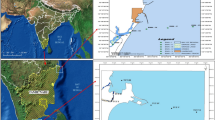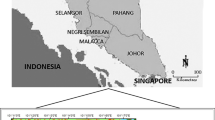Abstract
Petroleum hydrocarbon (PHC) concentration was monitored in water of estuaries, ports, and coastal transects up to 10-km distance in East Coast of India once in every year during 2002–2009. The highest concentration was observed at Haldia port (1.60–20.11 μg/l) due to the impact of hydrocarbon discharges from nearby oil refinery, petrochemical industries, handling of crude oils, etc. The concentration of PHC exhibited relatively higher values during low tide than the high tide in all the four estuaries indicating riverine inputs and land-based discharges, which contribute substantial amounts of PHC to the coastal water. Hoogly estuary recorded higher values of PHC (1.17–18.50 μg/l) due to the influence of industrial wastes, land runoff, and port activities. The spatial distribution of PHC estimated by the kriging method showed a variation in concentration of PHC over the whole region. To discriminate the dispersion pattern of PHC, principal component analysis (PCA) was performed using a correlation matrix.





Similar content being viewed by others
References
Acharya, B. C., Panigrahy, P. K., Nayak, B. B., & Sahu, R. K. (1998). Heavy mineral placer deposits of Ekakula Beach, Gahiramatha coast, Orissa, India. Resource Geology, 48, 125–136.
Ahrean, D. G., Meyer, S. P., & Standard, P. G. (1971). The role of yeasts in the decomposition of oils in marine environments. In E. D. Murray (Ed.), Developments in Industrial Microbiology (American Institute of Biological Sciences, Vol. 12, pp. 126–134). DC: Washington.
Al-Imarah, F. J. M., Ali, S. A., & Ali, A. A. (2010). Temporal and spatial variations of petroleum hydrocarbons in water and sediments from Northern parts of Shatt Al-Arab River, Iraq. Mesopotamian Journal of Marine Science, 25(1), 65–74.
Chouksey, M. K., Kadam, A. N., & Zingde, M. D. (2004). Marine Pollution Bulletin, 49, 637–647.
CPCB, 1993. Criteria for classification and zoning of coastal waters, coastal pollution control series; COPOCS/6/1993, pp.1-12.
Fondekar, S. P., & Alagarsamy, R. (1984). Petroleum hydrocarbon contamination along oil tanker routes in the Arabian Sea. Indian Journal of Marine Science, 13, 181–183.
Fondekar, S. P., Topgi, R. S., & Noronha, R. J. (1980). Distribution of petroleum hydrocarbon in Goa Coastal water. Indian Journal of Marine Sciences, 9, 286–288.
GESAMP (IMO/FAO/UNESCO/WMO/WHO/IAEA/UN/UNEP Joint Group of Experts on the scientific aspects of marine pollution) (1993).Impact of oil and related chemicals and wastes on the marine environment. GESAMP Reports and Studies Vol.50: pp. 180.
González, J. J., Viñas, L., Franco, M. A., Fumega, J., Soriano, J. A., Grueiro, G., Muniategui, S., López-Mahía, P., Prada, D., Bayona, J. M., Alzaga, R., & Albaigés, J. (2006). Spatial and temporal distribution of dissolved/dispersed aromatic hydrocarbons in seawater in the area affected by the prestige oil spill. Marine Pollution Bulletin., 53, 250–259.
Guler, C., Kaplan, V., & Akbulut, C. (2013). Spatial distribution patterns and temporal trends of heavy metal concentrations in a petroleum hydrocarbon contaminated site: Karaduvar Coastal Aquifer (Mersin, SE Turkey). Environmental Earth Science, 70, 943–962.
IMCO/FAO/UNESCO/WMO/WHO/IAEA/UN/GESAMP (1977). Impact of oil on the marine environment . Joint Group of Experts on the scientific aspects of marine pollution (GESAMP). Report and Studies No.6, 250 pp.
IOC-UNESCO (1984). Manual for monitoring oil and dissolved dispered petroleum hydrocarbons in marine waters and on beaches. Manuals and Guides No. 13, 35 pp.
Kadam, A. N., & Bhangale, V. P. (1993). Petroleum hydrocarbons in north-west coastal waters of India. Indian Journal of Marine Science, 22, 227–228.
Kennish, M. J. (1997). Practical handbook of estuarine and marine pollution., CRC Press, London 524 pp.
Law, R. J., Kelly, C. A., Graham, K. L., Woodhead, R. J., Dyrynda, P. E. J., & Dyrynda, E. A. (1997). Hydrocarbons and PAH in fish and shellfish from Southwest Wales following the Sea Empress oil spill in 1996 (In: proceeding, 1997, International Oil Spill Conference, pp. 205–211). Washington, DC: American Petroleum Institute.
Laws, E.A., (2000). Aquatic Pollution: A Introductory Text., John Wiley and Sons, Inc., New York pp. 432-479.
Lei, L., Mei, J., Yun-Long, W., Qi, Y., Guo-Dong, X., & Xin-Qiang, S. (2014). Characteristics of petroleum hydrocarbon pollution in surface sediments from the Changjiang Estuary and its adjacent areas. China Environmental Science, 34(3), 752–757.
Mohan, P. C., & Prakash, R. R. (1998). Concentration of petroleum hydrocarbons in bivalve Mytilopsis sallei and in the harbour wasters of Visakhapatnum, East coast of India. Indian Journal of Marine Science, 27, 496–498.
Nayak, B. B., Acharya, B. C., Panigrahy, P. K., & Panda, U. C. (2004). Assessment of heavy metals contamination in the coastal sea of Orissa, India. Pollution Research, 23, 791–803.
Panda, U. C., Sundaray, S. K., Rath, P., Nayak, B. B., & Bhatta, D. (2006). Application of factor and cluster analysis for characterization of river and estuarine water systems—a case study: Mahanadi river, India. Journal of Hydrology, 331, 434–445.
Panigrahy, P. K., Das, J., Das, S. N., & Sahoo, R. K. (1999). Evaluation of the influence of various physico-chemical parameters on coastal water quality, around Orissa, by factor analysis. Indian Journal of Marine Science, 28, 360–364.
Patil, U., Ravan, S., & Kaushal, A. (2003). GIS based air pollution surface modeling. The Asian GIS., 7(8).
Patra, A. K., Acharya, B. C., & Mohapatra, A. (2009). Occurrence and distribution of bacterial indicators and pathogens in coastal waters of Orissa. Indian Journal of Marine Science, 38, 474–480.
Qasim, S. Z., & Sengupta, R. (1988). Present status of marine pollution in India. Indian Journal of Fisherry Association, 18, 310–329.
Roy, S., Hens, D., Biswas, D., Biswas, D., & Kumar, R. (2002). Survey of petroleum–degradiny bacteria in coastal waters of Sundarban Biosphere Reserve. World Journal of Microbiology and Biotechnology, 18, 575–581.
Sarma, V. V., Varaprasad, S. J. D., Gupta, G. V. M., & Sudhakar, U. (1996). Petroleum hydrocarbons and trace metals in Visakhapatnam harbour and Kakinda Bay, East coast of India. Indian Journal of marine Science, 25, 148–150.
Satapathy, D. R., Salve, P. R., & Katpatal, Y. B. (2009). Spatial distribution of metals in ground/surface waters in the Chandrapur district (Central India) and their plausible sources. Environmental Geology, 56(7), 1323–1352.
Selvaraj, K., Jonathan, M. P., Mohan, V. R., Thangaraj, G. S., Pugalendhi, M., & Jayaraman, B. (1999). Observations of petroleum hydrocarbons and some water quality parameters during oil spill, near Madras harbour. Indian Journal of Marine Science, 28, 245–248.
Sengupta, R., Fondekar, S. P., & Topgi, R. S. (1978a). A survey of petroleum hydrocarbon concentration in the shelf regions and adjacent waters of the west coast of India. Indian Journal of Marine Science, 7, 12–14.
Sengupta, R., Fondekar, S. P., & Alagsamy, R. (1993). State of pollution in the northern Arabian Sea after the 1991 Gulf oil spill. Marine pollution Bulletin, 27, 85–91.
Sengupta, R., Naik, S., & Singbal, S. Y. S. (1978b). A study of fluoride, calcium and magnesium in the Northern Indian Ocean. Marine Chemistry, 6, 125–141.
Shailaja, M. S. (1988). The influence of dissolved petroleum hydrocarbon Residues and natural phytoplankton biomass. Marine Environmental Research., 25, 315–324.
Silva, C. S., Moreira, I. T. A., de Oliveira, O. M. C., Queiroz, A. F. S., Garcia, K. S., Falcao, B. A., Escobar, N. F. C., & Rios, M. C. (2014). Spatial distribution and concentration assessment of total petroleum hydrocarbons in the intertidal zone surface sediments of Todos os Santos Bay. Brazil. Environmental Monitoring and Assessment., 186, 1271–1280.
Sood, V. J. & Raju, G.R.K. (1984). Marine Pollution in India from production and transportation. Proceedings of Seminar on Marine Pollution prevention control and response. IMO. Bombay, Oct 8–13.
Veerasingam, S., Raja, P., Venkatachalapathy, R., Mohan, R., & Sutharsan, P. (2010). Distribution of petroleum hydrocarbon concentrations in coastal sediments along Tamilnadu Coast, India. Carpathian Journal of Earth and Environmental Sciences, 5(2), 5–8.
Venkatachalapathy, R., Rajeswari, V., & Balasubramanian, T. (2012). Spatial and temporal trends of petroleum hydrocarbons in surface sediments along the continental shelf of Visakhapatnam, Bay of Bengal, India. International Journal of Current Research., 4(12), 405–409.
Venkatachalapathy, R., Veerasingam, S., & Ramkumar, T. (2010). Petroleum hydrocarbon concentrations in marine sediments along Chennai Coast, Bay of Bengal, India. Bulletin of Environmental Contamination and Toxicology, 85, 397–401.
Yan, W., Chi, J. S., Wang, Z. Y., Huang, W. X., & Zhang, G. (2009). Spatial and temporal distribution of polycyclic aromatic hydrocarbons (PAHs) in sediments from Daya Bay, South China. Environmental Pollution, 157(6), 1823–1830.
Zinjarde, S. S., & Pant, A. (2002). Hydrocarbon degraders from a tropical marine environment. Marine Pollution Bulletin., 44, 118–121.
Acknowledgment
The authors gratefully acknowledge support of this work by the Ministry of Earth Sciences, New Delhi. The authors are thankful to Prof. B. K. Mishra, Director, CSIR-Institute of Minerals and Materials Technology, Bhubaneswar for his kind permission, encouragement, and motivation to publish this paper. Thanks are due to other team members of COMAPS project for their help during the sample collection and analysis. Financial grant received from the MoES, Government of India, for this project is gratefully acknowledged.
Author information
Authors and Affiliations
Corresponding author
Rights and permissions
About this article
Cite this article
Panigrahy, P.K., Satapathy, D.R., Panda, C.R. et al. Dispersion pattern of petroleum hydrocarbon in coastal water of Bay of Bengal along Odisha and West Bengal, India using geospatial approach. Environ Monit Assess 186, 8303–8315 (2014). https://doi.org/10.1007/s10661-014-4004-2
Received:
Accepted:
Published:
Issue Date:
DOI: https://doi.org/10.1007/s10661-014-4004-2




